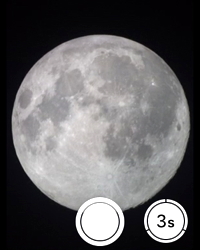Apple Watch Astrophotography
(initial report)
Posted: 2 June 2015
I received my Apple Watch (Sport Grey) on Monday, 1 June 2015. I set up the clock face for use in the observatory, although the display works fine in the daytime as well:

Note that I display UTC as well.
|
Open: Monday, 1 June 2015, 1840 MST Temperature: 93°F |
Session: 830 Conditions: Mostly clear, very breezy |
1847 MST: viewed Venus, then Jupiter, 83X, using the 8" LX200-ACF. Switched to the Baader 8-24mm Zoom Eyepiece and viewed Jupiter. The Great Red Spot was visible near the central meridian. 1852 MST: the moon Ganymede was visible. 1854 MST: the moons Europa and Io were now visible. 1911 MST: the moon Callisto finally became faintly visible.
I began setting up for iPhone 5s afocal imaging using the MX-1 Afocal Adapter with a 9mm (222X) eyepiece. Did a 15 second, slo-mo (120 fps) video of Jupiter. This is a stack of 1755 frames using Keith's Image Stacker:

Seeing was not ideal but the Great Red Spot is visible.
Using the Apple Watch connection to the iPhone camera I could see a live view of Jupiter on the Watch:

There is a shutter button on the Watch face that lets you take a photo with the phone. Unfortunately, it only supports taking photographs, not video recordings.
1928 MST: sunset. 1930 MST: began doing some Jupiter observing with the zoom eyepiece at 250X.
1939 MST: went back to Venus for some zoom eyepiece observing, then iPhone imaging using the MX-1 adapter at 222X.
1952 MST: the nearly full Moon had risen over the hill to the southeast, but it was still in the tree. 1955 MST: slewed the telescope to Saturn, which was over the hill but still in the tree. 2023 MST: Saturn cleared the tree, but was still too low for good viewing. The best view was at 167X with the zoom eyepiece. Switched back to the afocal adapter (222X) and did a 15 second slo-mo video recording. This is a stack of 1757 frames under poor seeing conditions:

2042 MST: the Moon cleared the tree. A Kissing Bug was seen on the observatory dome; terminated. Did some lunar observing using the zoom eyepiece. A very slight terminator was visible as the Moon was still about 12 hours from being 100% full phase. Took this iPhone 5s afocal 77X photo using the Watch as a remote shutter release:

2107 MST: resumed lunar observing, zoom eyepiece 250X. Then returned to Saturn. Seeing was still not good and the bright nearby Moon was hampering viewing of some of Saturn's moons. Titan was easy, but Tethys, Rhea, and Dione were more difficult to see against the bright sky background.
2122 MST: clouds were now in the western half of the sky so I began closing up for the night.
|
Close: Monday, 1 June 2015, 2136 MST Temperature: 77°F |
|
So, how did the night's bright objects appear on the Apple Watch? Here are four Watch screen captures that show Venus, Jupiter, Saturn, and the Moon:




I have been doing iPhone astrophotography for several years, typically using the wired earbuds/mic volume control as a remote shutter release. It will be very useful to use the Watch as a remote shutter release while being able to see a live view of the object being photographed.
Comments are welcome using Email. If you are on Twitter you can use the button below to tweet this report to your followers. Thanks.
Cassiopeia Observatory Home Page
Copyright ©2015 Michael L. Weasner / mweasner@me.com
URL = http://www.weasner.com/co/Reports/2015/06/02/index.html
